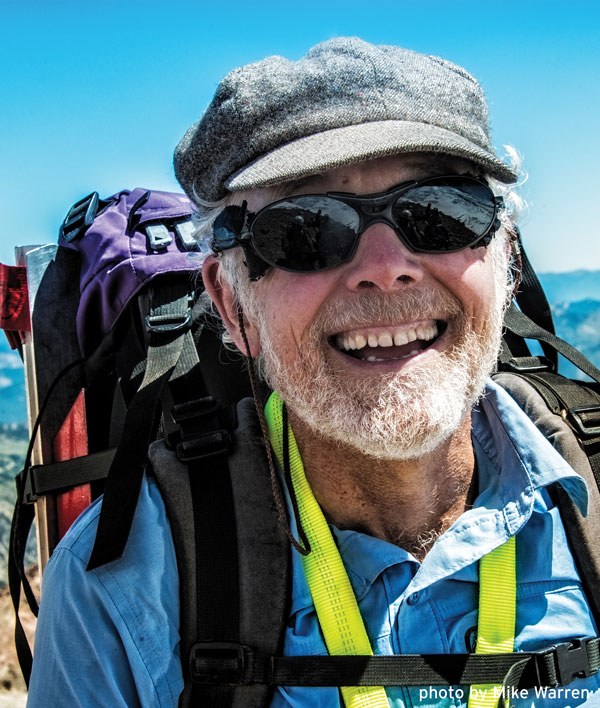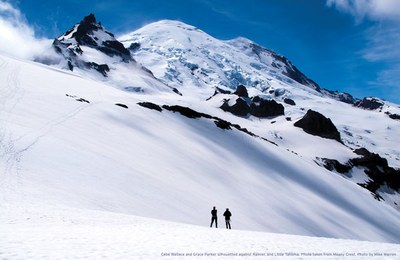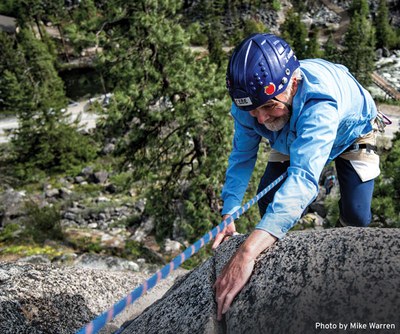
by Kristina Ciari, Mountaineers Marketing and Membership Manager
We’re aware some people perceive us as an ‘old guy’s club’. And while that may have been the case 60 years ago when we were inventing methods of climbing the highest and most remote peaks, it just isn’t true anymore.
Today’s members are more likely to describe The Mountaineers as active, high-quality, fun, helpful, and welcoming, and less likely to say we’re stand-offish, cliquish, intimidating, and elitist. This is compared to just three years ago. Most importantly, our ‘member satisfaction’ increased an astounding 20% in the last three years!
As the Membership and Marketing Manager, I’m incredibly excited about this information – but I’m not the only one. For this story on how climbing has changed within our organization in the last 40-years, I sat down with Cebe Wallace, head of the Seattle Basic Climbing Course and one of our outstanding climb leaders.
Change comes in all shapes and sizes
With white hair, two bad shoulders, and a bum knee, Cebe isn't exactly the person you expect to be leading change in our climbing courses. He is one of the ‘old guys’ after all. As a 40-year member, Cebe has been a Mountaineer since Nixon was forced to resign. He’s seen countless students graduate, have children, and teach their own kids to climb. He overcame an initial fear of 5th class rock and endured countless surgeries to be able to continue climbing. But thanks to medical wizardry, he continues to bring thoughtful leadership to our Basic course.
Cebe won’t tell you this, but he’s amassed his own cultish following amongst new basic students. His reputation for focusing on the ‘student experience’ precedes him. Students clamor to get into his SIG (Small Instruction Group) every year. Cebe has managed to make himself an institution for the Mountaineers - and he's excited about the changes he’s seen in the organization in the last 40 years.
In the 70's, Cebe had a friend who called The Mountaineers "old men in smelly flannel shirts” and Cebe will agree that we used to be quite rigid and limited. While some people still think we are that way, he would argue we’ve really changed behind the scenes. “We’re much more customer service oriented now,” he said. “ The experience of our students has improved. We go to huge lengths to try and assure that people are graduating and to support them in getting through the course.”
What’s changed? Well, for one we have a hugely expanded group of activities. It used to be: scramble, basic, and intermediate. Period. That was it. Now we have activities including: intro to glacier, intro to rock, intro to belay, aid and big wall, crag, rock and ice, and an advanced alpine course.
 All of these new classes have improved the established courses. Instructors aren’t tearing up the manual every year, but they aren’t keeping things the same either. Proof of that is the creation of the Intense Basic course: 10-days of concentrated instruction and field trips to teach all of the basic level requirements. It’s an opportunity for The Mountaineers to rethink the way in which we teach our courses while serving our members who have very limited time. And that isn’t the only change he’s excited about.
All of these new classes have improved the established courses. Instructors aren’t tearing up the manual every year, but they aren’t keeping things the same either. Proof of that is the creation of the Intense Basic course: 10-days of concentrated instruction and field trips to teach all of the basic level requirements. It’s an opportunity for The Mountaineers to rethink the way in which we teach our courses while serving our members who have very limited time. And that isn’t the only change he’s excited about.
He’s seen a cultural shift as well. Technology has made us much more agile and able to serve a wider need in the outdoor community. We now better understand the interests of our members and we have choices for just about everyone. We are constantly looking at new equipment and new techniques and are thus attracting and building a more diverse community of adventurers.
Change means a shift in perspective
Cebe grew up in California and spent lots of time at Lake Tahoe, where he went on countless hikes and nature walks with his paternal grandmother. According to Cebe, she was his “best buddy” and a hugely influential figure in his life. “We hung out and hiked a lot,“ he said. “She loved the wildflowers, and she fostered my love for the outdoors.” Not only that, she taught him an appreciation for opera. Cebe describes his two biggest passions as “the outdoors and opera.” And no, he doesn’t listen to opera when he’s outside – I asked.
A retired Air Force officer and former Deputy Director of Small Business Administration for Washington State, Cebe first moved to Seattle in 1969 with his late-wife Susan. He graduated with an MBA from UW in 1971, and spent a lot of time backpacking – mostly solo trips. On one of those trips, he realized he might be in over his head. To gain the skills he would need outdoors he decided to enroll in Basic Climbing in 1974.
When it came to registration time, he almost didn’t sign up. Accustomed to life as a lone traveler, Cebe was concerned about sharing his backcountry pursuits with others. "The funny part of my personal migration is, at the time, I was really into solo backpacking,” he said. “When I realized I needed the skills, I knew you had to climb in groups, but I just didn't want to be with other people. I just kind of had to suck it up.”
His fear of being with other people quickly dissolved in Basic. He fell in love with the outdoors all over again – only this time with sharing the outdoors with others. He graduated in 1975 and went on to become a snowshoe leader, where he got his first taste of teaching outdoor exploration. He was hooked.
He enrolled in Intermediate Climbing to be able to teach climbing. “After I graduated and climbed for a few years, I decided I wanted to come back and be a climb leader,” he said. “It was so much fun helping other people enter this world, do it right, and feel like they can master it.“ Cebe especially loves climbing because it’s such a personal sport. Most often our best performances in the mountains aren’t seen by anyone. The purity of those moments appeals to Cebe, and he loves giving people the skills so they can share in the fun. On teaching he says, “don’t we all just love sharing something we love?”
Change happens both slowly and all-at-once
Cebe has a theory about ‘the mountain gene’. He found there's a certain subset of people who ”get up into the alpine zone for the first time and this knot in their gut unties and they realize, ‘this is where I belong’. When you find these people who are fulfilled by the mountains and you can help them get there – well that's a pretty cool thing," he said.
And so for 30 years as a climb leader Cebe has been helping people unlock their own mountain genes by sharing his love and passion for the mountains. No one is more surprised about this evolution than Cebe, who now sees his fellow Mountaineers as the path to outdoor fulfillment rather than a hindrance. “The funny part is I started out saying ‘I'll suck it up because I need these other people to learn the skills’ but after several years it was the people that became the good part of it. The part I really enjoyed,” he said. “It’s a complete switch of my own psychology and what I get out of the mountains."
Cebe works hard to establish camaraderie in his courses to create an environment conducive to self-discovery. He teaches by setting a tone where people work together and take care of each other. “When that works, it's a really cool, transformative experience for everyone,” he says.
Watching these outdoor transformations motivates Cebe to continue giving so much of his time to The Mountaineers. He finds it odd that “we're still living down the reputation of going out and putting 50 people up a mountain,” but he’s willing to do all he can to squash that misconception and help move our organization forward. "The club is no longer the old guys doing the things old guys do the way they want to," he said. I couldn’t agree more.

This article originally appeared in our May/June 2014 issue of Mountaineer magazine. To view the original article in magazine form and read more stories from our bi-monthly publication, click here.
 Kristina Ciari Tursi
Kristina Ciari Tursi
